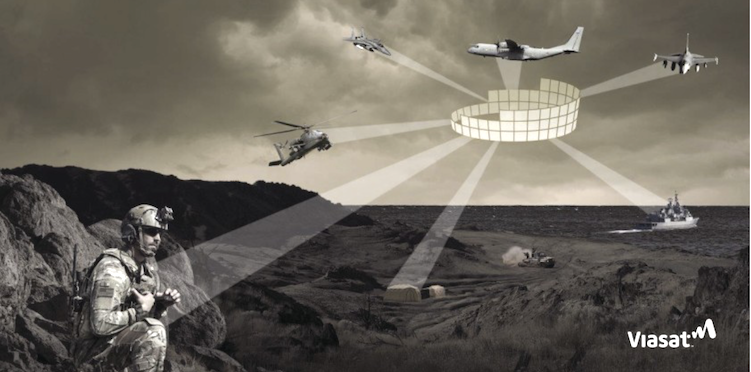The U.S. Department of Defense has a long heritage of sparking new communications technology inventions through its demanding requests for proposals, with success stories ranging from global positioning systems to cellular networks.
Government Business Council and Viasat call for tapping commercial satellite innovations to get technology into the hands of military personnel faster.
But the procurement process that drives these new technologies can take years, and today it is failing to keep pace with battlefield communications needs, according to a new survey released today from the Government Business Council and Carlsbad’s Viasat.

The above illustration highlights the Link 16 data communications system used by coalition armed forces for situational awareness.(Viasat)
The first-of-its-kind survey of over 300 active duty, often high ranking military and Department of Defense personnel found that less than half believe they have access to the level of connectivity they need.
“We have men and women in uniform that have far better connectivity at home than they do on a mission,” said Ken Peterman, president of government systems at Viasat. “The results of the survey force us to confront the reality that the status quo is not working. Technology is not getting to the warfighter fast enough.”
The survey is a bit self-serving for Viasat, which operates a high speed, secure satellite network that delivers in-flight Internet to commercial airlines and government VIP aircraft.
Over the next couple of years, the Carlsbad firm is launching a constellation of three new satellites — each with massive 1,000 gigabits per second capacity — to join its existing satellite fleet and provide global coverage.
The military is clearly an important potential customer for all this bandwidth. The survey aims to highlight that the Department of Defense can tap commercial satellite networks to meet the needs of soldiers, sailors and pilots instead of seeking to build that capability on a stand-alone network.
“We can’t take five to seven years to validate a requirement, budget the money, establish an acquisition strategy and finally issue a request for proposals,” said Peterman. “That takes too long. We need to move on a pulse that acquires cutting-edge capability.”
The survey found that 68 percent of respondents expect the same level of Internet connectivity on the battlefield as they get in the civilian world, said Lucy Bierer, author of the study for the Government Business Council.
Yet only 46 percent believe they have the level of connectivity necessary to execute their missions.
Reliability is a key issue, said Bierer. Ninety-eight percent of respondents said they have lost connectivity on missions, and only 27 percent felt the Defense Department’s budget priorities for communications technologies is adequate to keep pace with global threats.
“Our survey reveals an alarming number of defense professionals who lack the basic levels of connectivity needed to accomplish their objectives,” said Daniel Thomas, director of the Government Business Council.
Viasat has a significant $956 million government business, which makes up 46 percent of its annual revenue. The company supplies tactical radios, broadband modems, antenna systems, cybersecurity, satellite networking services and other products to military customers.
Peterman hopes the survey, which is planned annually going forward, can spark discussions about the capabilities that commercial Internet satellites can bring to the military.
“We need to help them understand what we’re doing,” said Peterman. “We have been operating a hybrid network since 2002. Very senior leaders, very demanding customers, fly on our network every day. We know how to move between different satellites, different bands, different frequencies and different ground infrastructure.”
He continued, “I think (the survey) is going to be very useful for both Department of Defense leadership and this industry that is involved in military communications.”
By Mike Freeman, from SanDiegoUnionTribune

